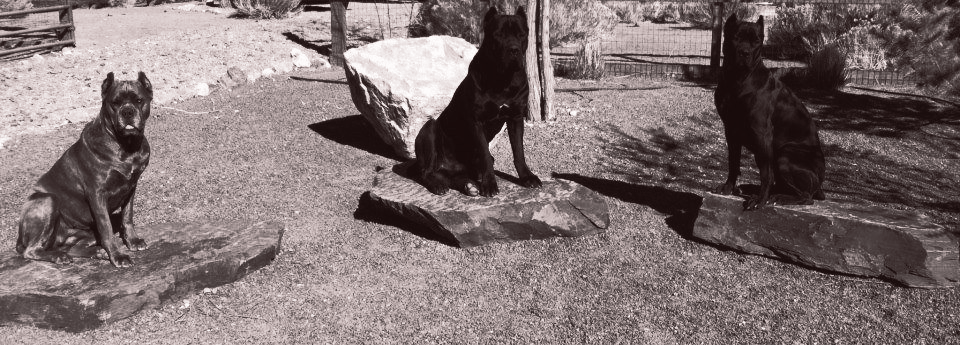GENERAL APPEARANCE
Ancient Italian breed medium-large size Molossus Dog. Sturdy, with a strong skeleton. Muscular and athletic, it moves with considerable ease and elegance. It has always been a property watchdog and hunter of difficult game such as the wild boar.
SIZE, PROPORTION, SUBSTANCE
A muscular, balanced, large-boned dog, rectangular in proportion. The length of the dog, measured from the point of the shoulder to the point of buttock is approximately 10% greater than the height of the dog measured from the highest point of the shoulder to the ground.
HEAD
Molossus, large, its total length reaches approximately one third of the height at the withers. Planes of the skull and muzzle are slightly convergent; they are not parallel. The circumference of the head measured at the cheekbones is more than twice the total length of the head; skin is firm and smooth. Skull: Viewed from the front, skull is wide and slightly curved; width is equal to the length. From the side, a prominent arch begins above the eyes and then flattens backward toward the occiput. Viewed from the top, it has a square appearance due to the zygomatic arches and powerful muscles swathing it. Well-defined due to developed and bulging frontal sinuses and prominent arch above the eyes.
Expression: Very alert and attentive. Some wrinkling on forehead occurs when alert.
Eyes: Medium-size, almond-shaped, not round or bulging, tight fitting rims preferred with only a minimal amount of haw being visible.
Eye Color: Dogs with black muzzles (coat colors of black, fawn or red, and these colors brindled) dark brown eyes are preferred. Gray muzzles (coat colors of gray, fawn or red and these colors brindled), lighter shades are approved. Pigmentation of the eye rims is complete, pigmentation of eye rim matches pigment color of dog.
Disqualification: Yellow bird of prey; blue eyes.
Nose: Large with well-opened nostrils, pigment color to match pigment color of the dog. Dogs with black pigment have black noses; gray pigmented dogs have gray noses; pigmentation is complete. The nose is an extension of the topline of the muzzle and does not protrude beyond nor recede behind the front plane of the muzzle.
Muzzle: Very broad and deep, width is almost equal to its length, which reaches approximately one third of the total length of the head; the depth of muzzle is more then 50% of the length of the muzzle.The top and bottom muzzle plains are parallel, and the nose and chin form a perpendicular line. Viewed from the front, the anterior face should look flat and form a trapezoid, wider at the bottom. Muzzle is not overly narrow or snipey.
Lips: Rather firm. Upper lips moderately hanging, they join under the nostrils to form an inverted “U.” Pigmentation matches color pigment of dog. Dogs with black pigment have black lips; gray pigmented dogs have gray lips.
Bite: Slightly undershot (no more than 1⁄4 inch) and level preferred. Scissor bite is acceptable, if parameters of the head and muzzle are correct. Dentition is complete. Incisors are in a straight line. No more than two missing teeth.
Disqualification: More than two missing teeth; wry mouth. Undershot more than 1/4 inch.
Neck: Slightly arched, flowing smoothly into the shoulders with a small amount of dewlap. The length of the neck is approximately one third the height at the withers.
Body: Depth of the ribcage is equal to half the total height of the dog, descending slightly below the elbow. Ribs are long and well sprung. Moderate tuck up.
Chest: Broad, well-muscled, strong forefront.
Back: Wide, strong, muscular. Highest part of shoulder blade slightly rising above the strong, level back.
Loin: Well-muscled, and harmoniously joined to the back.
Croup: Long, wide, slightly sloping. Rump should be quite round due to muscling.
Tail:
Tail set is an extension of the backline. It is thick at the root with not much tapering at the tip. When not in action, carried low, otherwise horizontal or slightly higher than back, not to be carried in a vertical position. It is docked at the fourth vertebrae. In the case of natural tails, the tip reaches the hock but not below. Carried low, it is neither broken nor kinked but supple. Hanging when the dog is in repose; generally carried level with the back or slightly above the level of the back when the dog is in action, without curving over the back or being curled.
Disqualification: A natural tail that is atrophied or a natural tail that is knotted and laterally deviated or twisted.
FOREQUARTERS
Strong and muscular, well-proportioned to the size of the dog. Straight when viewed from the front or side; height of the limb at the elbow is equal to 50% of the height at the withers.
Shoulders: Muscular, laid back.
Upper arms: Strongly muscled, with good bone, powerful.
Elbows: Held parallel to the ribcage, turning neither in nor out.
Forelegs: Straight and with good bone, well muscled.
Pasterns: Almost straight, strong but flexible.
Feet: Round with well-arched toes (catlike). Lean, hard, dark pads and nails, except in the case of white toes. Front dewclaws: Can remain or be removed, if left intact should only be a single dewclaw on each leg.
As a whole, they are powerful and strong, in harmony with theforequarters.Straight when viewed from the rear or front.
Thighs: Long, wide, angulated and well-muscled.
Stifle: Should be moderately angulated, strong.
Legs: Strong bone and muscle structure.
Hocks: Wide set, thick and clean, let down and parallel when viewed from behind. Rear pastern: straight and parallel.
Rear dewclaws: Any rear dewclaws are removed.
Hind feet: Slightly more oval-shaped and less-arched toes.
HINDQUARTERS
As a whole, they are powerful and strong, in harmony with the forequarters. Straight when viewed from the rear or front.
Hips: As a whole, they are powerful and strong, in harmony with the forequarters. Straight when viewed from the rear or front.
Thighs: Long, wide, angulated and well-muscled.
Stifle: Should be moderately angulated, strong.
Legs: Strong bone and muscle structure.
Hocks:Wide set, thick and clean, let down and parallel when viewed from behind. Rear pastern: straight and parallel.
Rear dewclaws: Any rear dewclaws are removed.
Hind feet: Slightly more oval-shaped and less-arched toes.
COAT
The coat is short, stiff, shiny, adherent and dense with a light undercoat that becomes thicker in cold weather.
COLOR
Acceptable colors are black, lighter and darker shades of gray, lighter and darker shades of fawn, and red. Brindling is allowed on all of these colors. Solid fawn and red, including lighter and darker shades, have a black or gray mask. The mask does not go beyond the eyes. There may be a white patch on the chest, throat, chin, backs of the pasterns, and on the toes.
Disqualification: Any color with tan pattern markings as seen in black-and-tan breeds.
GAIT
The movement is free flowing and powerful, yet effortless, with strong reach and drive. As the dog accelerates, the feet converge toward a center line of gravity in a near-single track. When viewed from the side, the topline remains level, with minimal roll or bounce.
TEMPERAMENT
The Cane Corso as a protector of their property and owners is unequaled. Intelligent, they are easily trained. Noble, majestic and powerful, their presence is impressive. They are docile and affectionate to their owner, loving with children and family.
SUMMARY
The overall conformation of the dog should be well-balanced and proportionate. The foregoing description is that of the ideal Cane Corso; any deviation from the above described dog is penalized to the extent of the deviation.
DISQUALIFICATIONS
Yellow bird of prey; blue eyes.
More than two missing teeth; wry mouth.
Undershot more than 1⁄4 inch.
Any color with tan pattern markings as seen in black-and-tan breeds.
A natural tail that is atrophied or a natural tail that is knotted and laterally deviated or twisted.
About the Breed
The Cane Corso is large, well muscled and more athletic than most other mastiffs. The overall impression should be of power, balanced with athleticism.
Cane Corso are easy to obedience train, have a willingness to please, and form a close attachment with their primary owner. They are also excellent family dogs and especially tolerant of children in the immediate family. As puppies, a Corso must have strong leadership and training, and although they easily learn the basic commands, any owner understands that the difficult part is controlling and molding the Corso’s strong protective instinct. Powerful and imposing, a Cane Corso is highly suspicious of strangers, and for this reason aggression should never be encouraged. Because of their need to keep the status quo, a Corso often dislikes new things, animals, and people, so the owner must be careful when introducing the dog to new places and people. Cane Corso tend to be a quiet breed, though they will bark at anything about which they are unsure. For the most part, they like nothing better than staying next to their owner all the time. They are extremely loyal.
A true Corso should be indifferent when approached and should only react when a real threat is present. Of course, socialization is the key to controlling the dog’s natural protective instincts, because a Corso will find anything threatening if not properly socialized as a puppy. If socialized properly as a puppy, a Cane Corso can get along with other dogs and people. Corso are historically working dogs that need exercise and are at their best when they have a job to do.
The average life span of a Cane Corso is 10 to 11 years.
The Cane Corso is not the perfect breed for everyone. As a breed they have a few features that some people find charming, but that some people find mildly unpleasant and some people find downright intolerable. There are different breeds for different needs. Considering that there are over 200 purebred breeds of dogs in the world, maybe you’d be better off with some other breed.
If you are not familiar with Cane Corso, we encourage you to educate yourself as thoroughly as possible. This breed is known for it's dominant personality and is best suited to be placed with a confident and experienced dog owner.
The Cane Corso is not the perfect breed for everyone…
Do not get a Cane Corso if you are attracted to the breed chiefly by its appearance. A dog is not an accessory! If you would like a dog because you think he looks tough or makes you look tough, this is not a reason to get a Cane Corso.
CONCLUSION
If all the preceding “bad news” about Cane Corso’s hasn’t turned you away from the breed, then by all means DO GET A CANE CORSO! They are every bit as wonderful as you have heard!
If buying a puppy, be sure to shop carefully for a responsible and knowledgeable breeder who places high priority on breeding for sound temperament and trainability and good health in all matings. Such a breeder will interrogate and educate potential buyers carefully. Such a breeder will continue to be available for advice and consultation for the rest of the puppy’s life and will insist on receiving the dog back if ever you are unable to keep it.
Register to get the latest News!
We will get back to you as soon as possible
Please try again later






